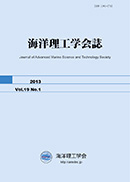Volume 27, Issue 1
Displaying 1-8 of 8 articles from this issue
- |<
- <
- 1
- >
- >|
Original Paper
-
2022Volume 27Issue 1 Pages 1-14
Published: July 30, 2022
Released on J-STAGE: August 27, 2022
Download PDF (2500K) -
2022Volume 27Issue 1 Pages 15-30
Published: July 30, 2022
Released on J-STAGE: August 27, 2022
Download PDF (2896K) -
2022Volume 27Issue 1 Pages 31-43
Published: July 30, 2022
Released on J-STAGE: August 27, 2022
Download PDF (1921K) -
2022Volume 27Issue 1 Pages 45-53
Published: July 30, 2022
Released on J-STAGE: August 27, 2022
Download PDF (4853K) -
2022Volume 27Issue 1 Pages 55-62
Published: July 30, 2022
Released on J-STAGE: August 27, 2022
Download PDF (13746K)
Short Paper
-
2022Volume 27Issue 1 Pages 63-72
Published: July 30, 2022
Released on J-STAGE: August 27, 2022
Download PDF (5310K) -
2022Volume 27Issue 1 Pages 73-79
Published: July 30, 2022
Released on J-STAGE: August 27, 2022
Download PDF (5240K) -
2022Volume 27Issue 1 Pages 81-93
Published: July 30, 2022
Released on J-STAGE: August 27, 2022
Download PDF (14078K)
- |<
- <
- 1
- >
- >|
